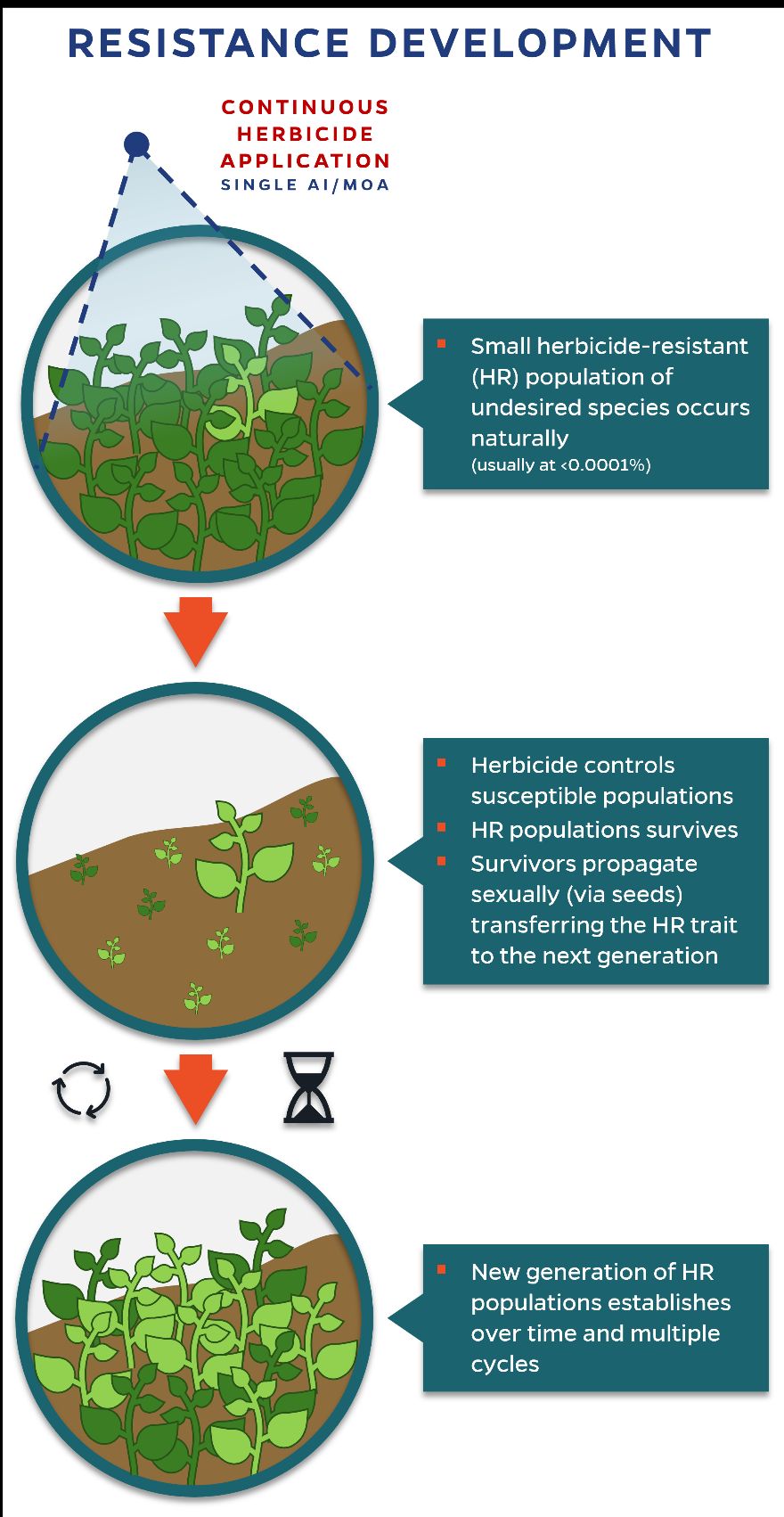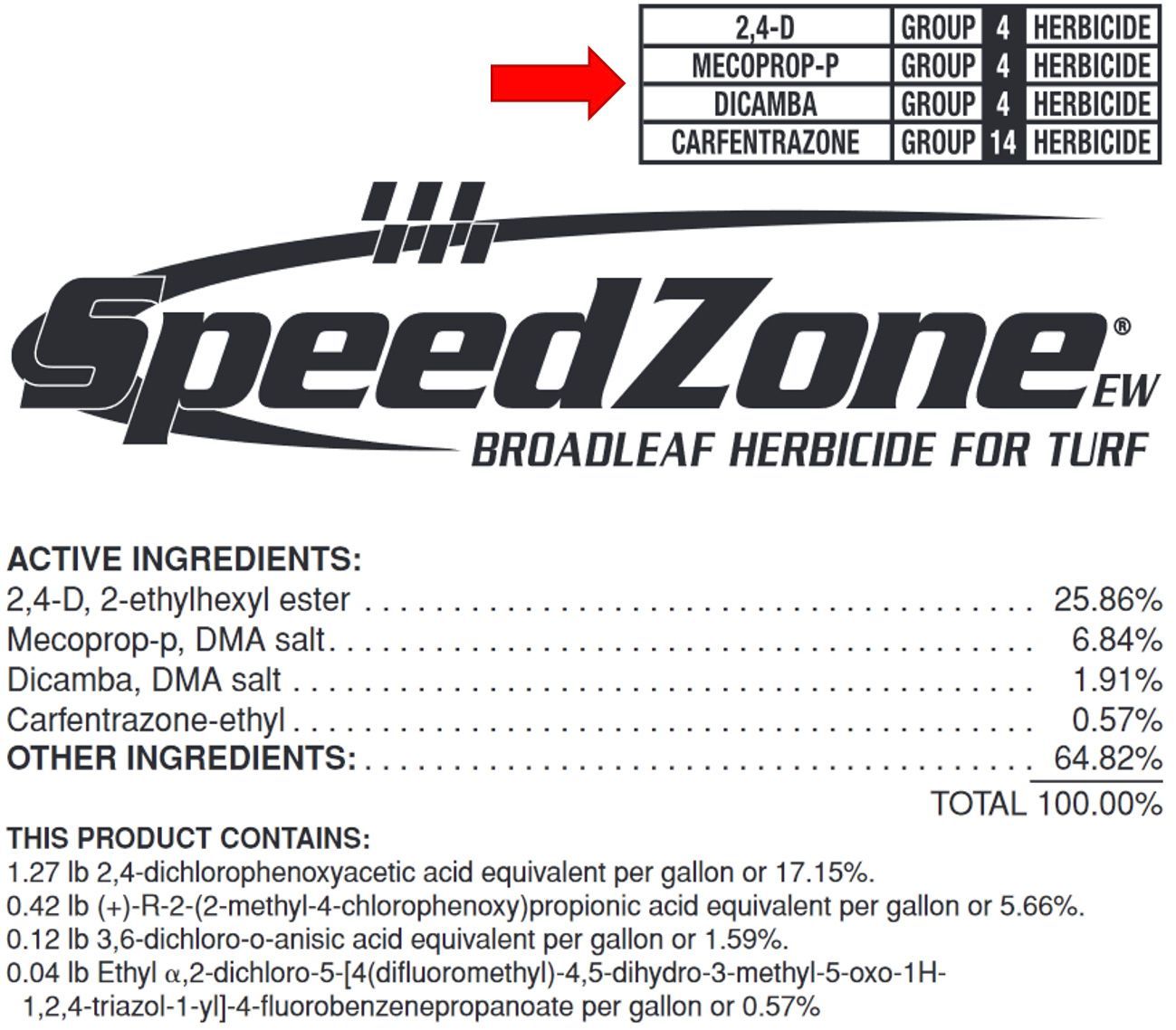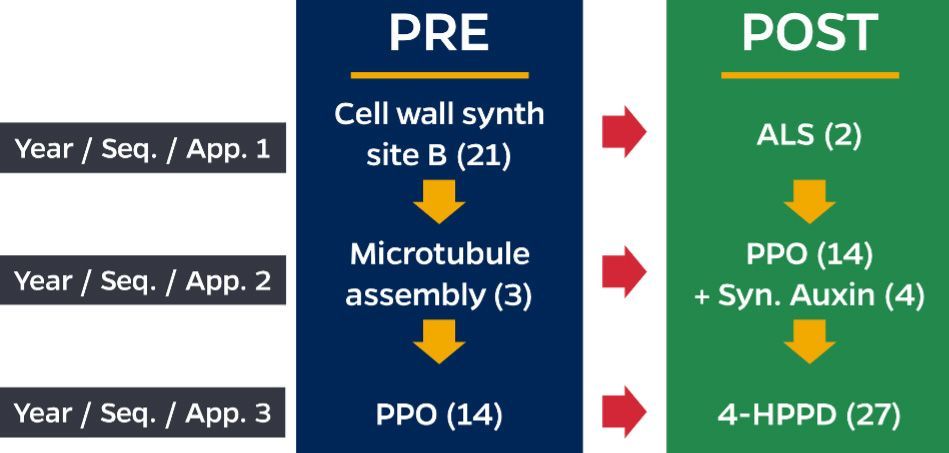Target Audience
This document is a tool for turfgrass professionals, sod producers, golf course superintendents, athletic and sports fields managers, landscape managers, and extension specialists to help develop herbicide programs that reduce the risk of herbicide resistant weeds in turfgrass systems.
Introduction
Herbicides are the most efficacious tool for weed control in turfgrass. Many common and/or troublesome weeds are not adequately controlled for various reasons such as lack of access to efficacious active ingredients (AIs) and use restrictions to selected turf species. Weed species are also capable of adapting where these poorly controlled become more common. If not successfully controlled, these weeds can spread creating a cascade of environmental, management, and economic issues. In addition, certain weeds have a high potential for developing resistant populations. One such weed is goosegrass [Eleusine inidica (L.) Gaertn.], which is a difficult to control annual grassy weed in most Florida turfgrass systems. Populations resistant to current industry standard herbicides such as prodiamine, oxadiazon, and metribuzin have been confirmed in various turfgrass settings.
For turfgrass managers, resistant populations lead to a further limitation of reliable control options. This may force managers to employ less efficacious chemistries, or overuse options still capable of providing satisfactory control, directly resulting in increased management costs. Alternative products can be significantly more expensive while less efficacious products often require more applications to achieve desired weed control. These strategies can also pose an elevated risk of turfgrass damage. While herbicide safeners and/or safening strategies could reduce the potential for turfgrass injury, they generate additional logistic issues and/or expenses and effects may be inconsistent.
Successfully preventing resistance problems requires a complete understanding of what herbicide resistance is, how it develops, and effective strategies for mitigation. To achieve this, it is also crucial to understand the general nature of herbicidal activity within a plant.
Herbicide Mode of Action and Herbicide Resistance Explained
The term mode of action (MOA) refers to the entire sequence of events occurring within the plant treated with an herbicide (including its uptake, translocation, and metabolism), from first contact until the death of the susceptible plant. The term mechanism of action (MoA) is more specific and applies to a particular chain of biophysical (e.g., electron flow inhibition, cell division disruption, protein binding) or biochemical (e.g., enzyme inhibition) processes which herbicide disrupts (e.g., by inhibition or overstimulation). Although some herbicides may function via several MOAs, only one is considered principal, and is used to describe the herbicide’s effect on plant. There is also a term site of action, which refers to a particular location within a cell where these processes occur (e.g., chloroplasts or particular photosystems in the case of photosynthesis, mitochondria in the case of respiration, nuclei in the case of mitosis, specific binding sites on a protein in the case of enzymes). Some confusion may arise as sometimes those three terms are incorrectly considered as interchangeable by individuals referring to the MOA, which is also used as one of the characteristics for herbicide classification. Being fundamental to proper herbicide resistance management, it is the MOA which is further discussed in this publication.
Herbicide resistance is commonly defined as “the inherited ability of a plant to survive and reproduce following exposure to a dose of herbicide normally lethal to the wild type.” A more current weed-specific definition describes herbicide resistance as “the evolved capacity of a previously herbicide-susceptible weed population to withstand an herbicide and complete its life cycle when the herbicide is used at its normal rate in an agricultural situation.” In both cases herbicide resistance is distinct from herbicide tolerance, which is described as the “ability of a plant to remain uninjured by a dose of an herbicide normally lethal to other plant species.”
Overall, while HR results from over-reliance on herbicides as a sole mean for weed control, herbicides do not induce any gene mutations resulting in herbicide resistance. Those occur naturally and spontaneously. Subsequently, herbicide resistance can be transferred between generations via sexual reproduction in plants producing seeds. Such risk is higher in weeds with an annual life cycle compared to perennial plants that do not rely completely on seed production (i.e., sexual reproduction) for persistence across multiple seasons.
Herbicide resistance usually develops where an individual herbicide or herbicides with the same MOA are used excessively (Figure 1). This occurs during continuous and repeated applications over extended periods of time (e.g., multiple seasons) as the primary control of particular weed species. Such an approach creates a high selection pressure on the targeted weed populations. In most cases, herbicide resistance is already present at very low levels (often <0.0001%). While susceptible plants are removed by the herbicide, the herbicide resistant individuals grow and reproduce and eventually become dominant. Also, weeds may evolve herbicide resistance to other herbicides within the same MOA. However, this is not the case with all MOAs.

Monoculture settings of perennial crops, such as turfgrass, additionally favor the development of herbicide resistant populations. In these situations, crop rotation does not occur, eliminating herbicide options with differing MOAs that would be used in rotational crops. Moreover, proven agronomic management practices that alleviate the risk for herbicide resistance development such as tillage and cultivation, cover cropping, and fallow periods cannot be employed in established turfgrass settings. Therefore, the use of herbicides to control weeds in turfgrass settings becomes a necessity.
Strategies for Reduction of HR Development Risk
Entities such as Weed Science Society of America (WSSA) and the Herbicide Resistance Action Committee (HRAC) have developed MOA-based herbicide classification systems to help end users better address arising herbicide resistance issues. In the past, there were differences between these individual systems (e.g., numerical coding in WSSA’s system, alphabetical coding in HRAC’s system). In 2020, the HRAC updated their classification system to capture new active ingredients and to reflect the current state of knowledge. Also, the classification was harmonized, and a transition was made from alphabetical (now referred to as "HRAC Legacy") to numerical codes to ensure global sustainability of the system. A summary of MOAs and their classifications according to the WSSA and HRAC, along with a comprehensive list of herbicide active ingredients registered for use in turfgrass (including their chemical families) and their respective WSSA/HRAC MOA groups, is provided in Table 1. Additionally, Table 2 summarizes turfgrass tolerance (based on label information) for the most prevalent turfgrasses managed in Florida. Alphabetical codes are no longer used in the U.S., thus are not included in this publication. Moreover, in an effort to adopt responsible resistance management practices, CropLife International members have voluntarily committed to include MOA icons and WSSA/HRAC groups on all herbicide product labels (Figure 2).

There are several strategies designed to delay or prevent herbicide resistance development in weeds. The most practical and effective tactic is to rotate the use of herbicides with different MOAs. Simply put, if two herbicides have the same MOA number or code, regardless of different names or active ingredients, they affect weeds in the same way. As previously explained, frequent and repeated use of herbicides with the same MOA will increase the risk of herbicide resistance development. Conversely, using a diverse herbicide program that either rotates or combines herbicides with different MOAs will help delay the development of resistant weeds.
MOA rotation helps delay herbicide resistance because changing the MOA reduces the chances of survival and reproduction of herbicide resistant weeds. In simple terms, if a weed survives a herbicide application with one MOA because it is resistant, the problem can be controlled if the surviving weed is treated with herbicide with a different MOA to which it has not become resistant.
As shown in Table 2, most herbicides for preemergence (PRE) control are inhibitors of microtubule assembly (Group 3) and mitosis inhibitors (Group 15), while postemergence herbicides are predominantly acetolactate synthase (ALS) inhibitors (Group 2). Although many turfgrass professionals base their weed management programs solely on Groups 3 and 2, it is critical that herbicides from other MOA groups be included also. To ensure that the most frequently used herbicides in turfgrass will continue being effective for a long time, herbicides with different MOAs should be included in weed management programs even if they are not as effective or require repeat applications to provide the desired level of control.
Example of groups that are useful for MOA rotation with microtubule assembly inhibitors (Group 3) and mitosis inhibitors (Group 15) in PRE programs in turfgrass:
- Group 21 – inhibitors of cell wall synthesis at site B
- Group 29 – inhibitors of cell wall synthesis at site C
- Group 8 – inhibitors of lipid synthesis other than Acetyl CoA Carboxylase (ACCase) inhibitors
- Group 14 (specific active ingredients) – oxadiazole family of protoporphyrinogen oxidase (Protox, PPO) inhibitors
Example of groups that are useful for MOA rotation with ALS-inhibitors (Group 2) in POST programs in turfgrass:
- Group 27 – inhibitors of 4-hydroxyphenyl-pyruvatedioxygenase (4-HPPD)
- Group 5 – inhibitors of photosynthesis at photosystem II (PSII) site A
- Group 14 (specific active ingredients) – triazolinones family of PPO inhibitors
- Group 4 – synthetic auxins
- Group 6 – inhibitors of PSII site B
Example of groups which, due to their dual activity, could be considered for rotation in both PRE and POST programs in turf:
- Group 5 (specific active ingredients) – triazine family of PSII site A-inhibitors
- Group 8 (specific active ingredients) – benzofuran family of inhibitors of lipid synthesis other than Acetyl CoA Carboxylase (ACCase) inhibitors
- Group 3 (specific active ingredients) – benzamide family of microtubule assembly inhibitors
- Group 14 (specific active ingredients) – N-phenylphthalimide family of PPO inhibitors
- Group 30 – tyrosine aminotransferase inhibitors
There are two ways to rotate herbicides in turfgrass settings. The first is to rotate herbicide MOAs from year to year (Figure 3). For example, one could use a Group 21 PRE herbicide in the fall of year 1 and change to Group 3 PRE herbicide in the fall of year 2. Conversely, one could use Group 2 POST herbicide in year 1 and then switch to Groups 4 and 14 POST herbicides in year 2.

The second way is to rotate herbicides within a season (Figure 3). In this approach, the rotation cycle may apply to either individual applications or their entire sequences (i.e., initial application followed by supplemental applications as prescribed on the herbicide label). Overall, there are three possible scenarios applicable to this approach. In all of them, the tactic is to change the herbicide MOA to eradicate plants surviving previous application(s), which are often referred to as “escapes.” This approach is called the "double-knock down" strategy because weed control is based on two consecutive actions.
In the first scenario, one could apply a Group 21 PRE herbicide at the beginning of the season and switch to a Group 2 POST herbicide to kill plants that may still be emerging and were not prevented by the initial PRE application.
The second and third scenarios are similar to each other and often apply to environments with extended growing seasons, such as Florida’s. For example, one could use a Group 21 PRE herbicide prior to expected germination of a target weed and then perform a sequential, follow-up application. However, when residual efficacy of those treatments is expected to diminish, then one could switch to a Group 3 PRE herbicide to ensure no germination occurs later in the season. Similarly, when applying POST herbicides, MOAs should be rotated between 2 POST applications/sequences within same season to target the escapes from the initial application.
Another strategy is to use either tank-mixes or premixes of various active ingredients containing different MOAs. There are also many premix options available in the market; however, most contain 1 to 3 active ingredients from the same MOA group, which is not beneficial from a herbicide resistance management standpoint. The addition of certain active ingredients or even MOAs will broaden their efficacy on additional groups/species of weeds; however, they will not boost the efficacy on the target weed. Therefore, from a herbicide resistance management perspective, it is important that all components of either a tank-mix and/or a rotation program have the capacity to control the target weed.
Lastly, the turf’s own ability to outcompete other species is the key to both successful weed control and reduced herbicide resistance risk. A healthy, dense turfgrass enhances competitiveness against weeds and reduces their encroachment. To ensure successful weed control and to minimize herbicide resistant weed development, all of the strategies discussed should be combined with practices aimed to provide the best possible growing conditions for turfgrass along with proper sanitation practices to avoid reintroduction of problematic plants.
Table 1. Mode of action (MOA) classification according to the Weed Science Society of America (WSSA) and the Herbicide Resistance Action Committee (HRAC) for preemergence (PRE) and postemergence (POST) herbicides registered for use in turfgrass.
Table 2. Turfgrass tolerance (based on label information) to professional-grade preemergence (PRE) and postemergence (POST) herbicides, organized by mode of action (MOA) classification as defined by the Weed Science Society of America (WSSA) and the Herbicide Resistance Action Committee (HRAC).